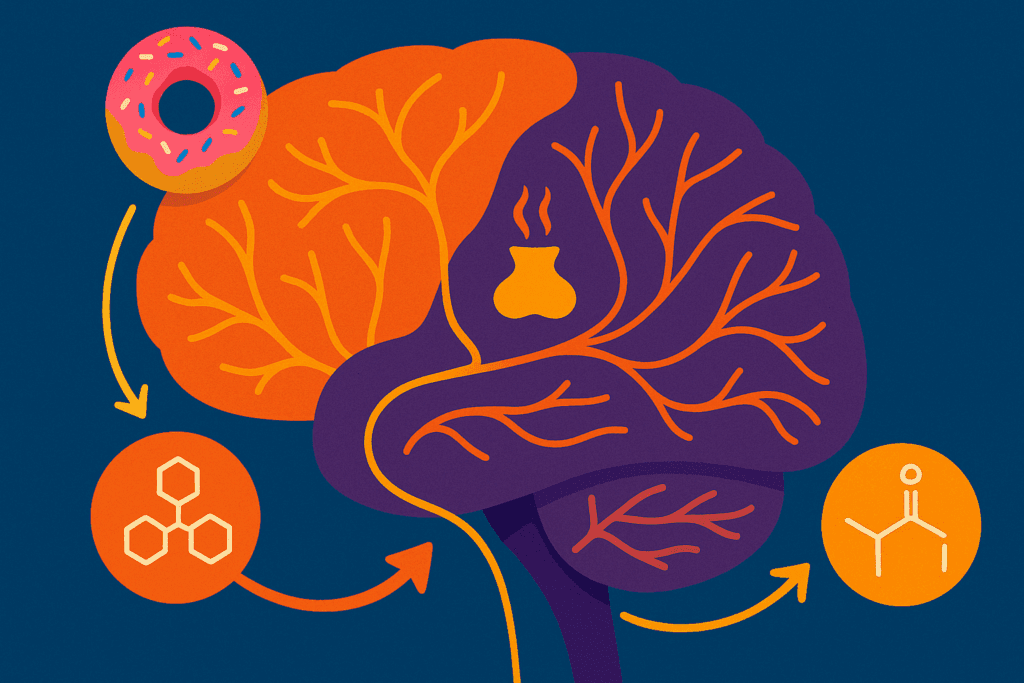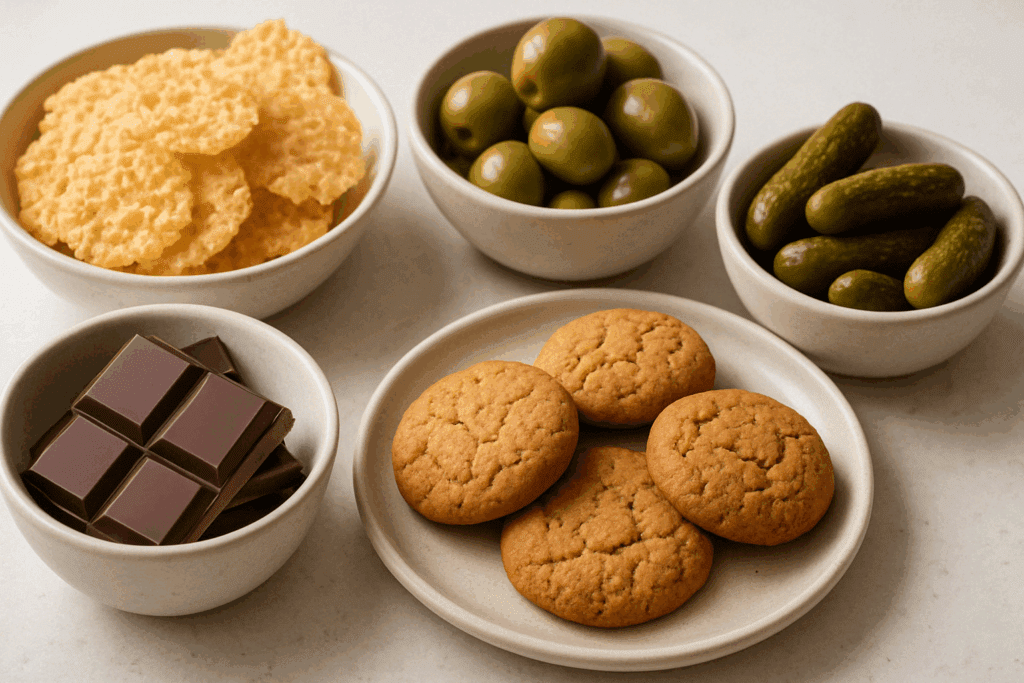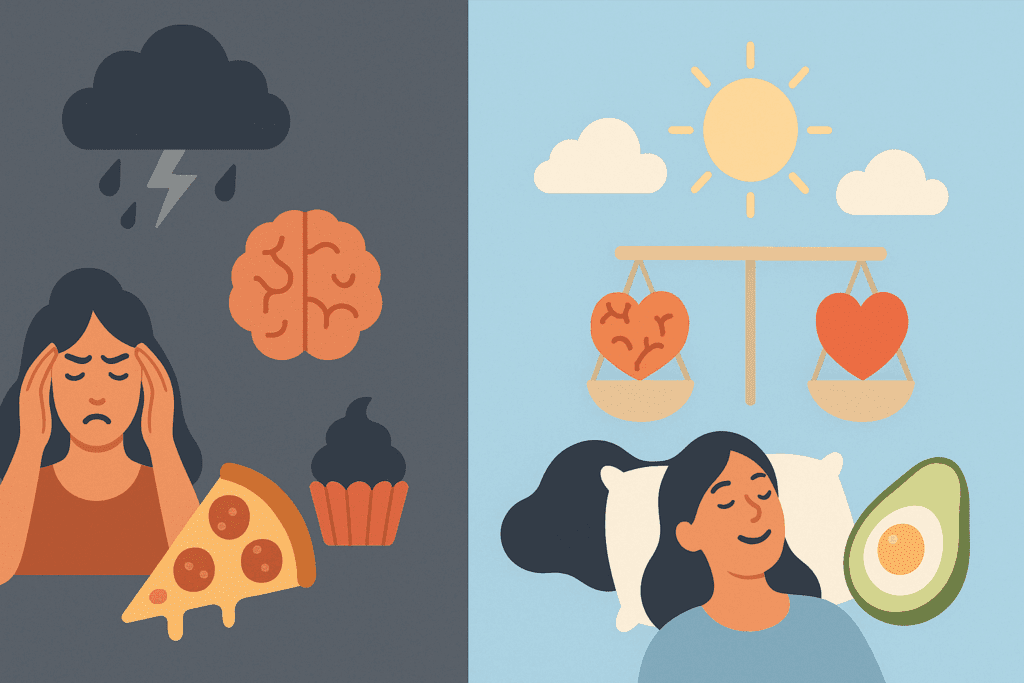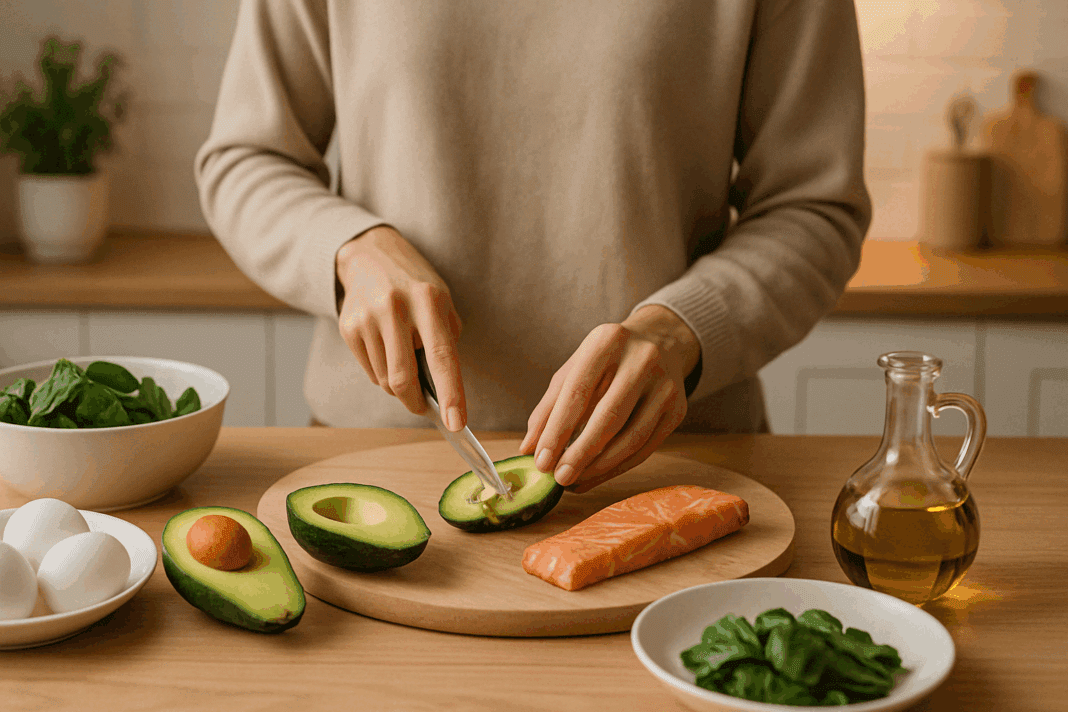Introduction: Why Keto Diet Cravings Are Common—and What You Can Do About Them
The ketogenic diet, often referred to simply as “keto,” has gained widespread popularity for its ability to help people lose weight, improve metabolic health, and reduce inflammation. By dramatically lowering carbohydrate intake and emphasizing healthy fats, the keto diet helps shift the body into a state of ketosis, where fat becomes the primary source of fuel instead of glucose. While this metabolic switch can yield powerful health benefits, it also comes with a set of unique challenges—perhaps none more frustrating than persistent food cravings. For many individuals, especially those new to keto, dealing with sudden urges for high-carb comfort foods can feel like a daily battle. Understanding the science behind these cravings, their psychological triggers, and evidence-based strategies to manage them is key to sustaining long-term success on a ketogenic plan.
These cravings on keto are not a sign of personal failure—they’re often a result of physiological adaptations, hormonal shifts, emotional associations with food, and even gut microbiota changes. By recognizing the root causes of these cravings and addressing them with intentional strategies, keto followers can regain control over their eating habits without feeling deprived. This article dives deep into the psychology, physiology, and nutritional science behind keto diet cravings and offers practical, research-backed solutions to help you navigate them naturally and effectively. Whether you’re just starting keto or have been following it for months, these insights will empower you to manage cravings with confidence and consistency.
You may also like: Why Am I Craving Sweets All of a Sudden? Expert-Backed Reasons and How to Stop Sugar Cravings Naturally

Understanding the Root of Cravings on Keto: The Science Behind the Urge
To effectively manage cravings on keto, it’s essential to understand what causes them in the first place. One of the primary culprits is the body’s adaptation process when transitioning into ketosis. Most people entering a ketogenic diet have been heavily reliant on carbohydrates as their main source of energy for most of their lives. As the body begins to burn fat for fuel instead, it goes through a period of adjustment that may include headaches, fatigue, irritability—and intense cravings, particularly for sweet or starchy foods. This transition, often referred to as the “keto flu,” is temporary, but the cravings can be quite strong during this time.
Hormones also play a significant role. The sudden drop in carbohydrate intake influences hormones like insulin, leptin, and ghrelin. Leptin, the hormone responsible for satiety, and ghrelin, which stimulates hunger, can become temporarily imbalanced. This hormonal shift may trick the brain into thinking it’s in a state of deprivation, triggering cravings for energy-dense foods. Furthermore, the brain itself runs largely on glucose under normal conditions. While it can adapt to using ketones for fuel, this process takes time, and during the transition, the brain may send strong signals for fast-acting carbs.
On a psychological level, many food cravings are rooted in habit and emotion. For example, if someone is used to unwinding with a bowl of pasta after work or rewarding themselves with dessert, the sudden removal of these foods can leave a psychological void. Emotional eating—using food as a coping mechanism for stress, boredom, or sadness—can further exacerbate cravings. Recognizing that cravings are not just about hunger but also about comfort and routine can help individuals develop more holistic strategies to cope.

Balancing Macros to Beat Keto Diet Cravings Naturally
One of the most effective ways to reduce keto diet cravings is to ensure that your macronutrients—fat, protein, and carbohydrates—are properly balanced. A well-formulated ketogenic diet typically consists of about 70% fat, 20–25% protein, and only 5–10% carbohydrates. If you are not consuming enough fat, you may feel unsatisfied after meals, which can lead to cravings. Fat is the most calorie-dense macronutrient, and when used properly on keto, it provides long-lasting satiety. Healthy fats such as avocados, olive oil, nuts, seeds, and fatty fish help keep hunger in check and cravings at bay.
Protein also plays a critical role. While keto is not a high-protein diet, adequate protein intake is essential for preserving lean muscle mass and supporting metabolic function. Protein is particularly helpful in managing cravings because it slows digestion and promotes feelings of fullness. Including moderate portions of high-quality protein—such as grass-fed beef, eggs, tofu, or tempeh—can help reduce the impulse to snack unnecessarily.
Carbohydrates must be managed carefully on keto, but the type of carbohydrates consumed matters significantly. Incorporating low-glycemic, fiber-rich vegetables such as leafy greens, broccoli, zucchini, and cauliflower can add volume and satisfaction to meals without knocking you out of ketosis. These foods also support gut health, which is increasingly being linked to appetite regulation and emotional well-being. A diet lacking in fiber can lead to constipation and increased cravings, while a fiber-rich keto plan helps with fullness and digestive comfort.

The Role of Hydration and Electrolyte Balance in Managing Cravings
What may feel like hunger or a craving is often a sign of dehydration or electrolyte imbalance—common concerns for individuals on a ketogenic diet. When the body switches to ketosis, insulin levels drop significantly, which in turn causes the kidneys to excrete more sodium and water. As a result, you may find yourself more prone to dehydration and losing important electrolytes like sodium, potassium, and magnesium. These imbalances can lead to symptoms such as fatigue, brain fog, and, surprisingly, carb cravings.
To prevent this, staying well-hydrated is non-negotiable. Aim to drink enough water throughout the day—typically more than you would on a standard diet. Supplementing with electrolytes can also be a game-changer. Adding a pinch of sea salt to water or using an electrolyte supplement can help stabilize fluid balance and reduce cravings associated with nutrient deficiencies. Many people find that once they start supporting their hydration and electrolyte needs, their cravings on keto diminish significantly.
Magnesium, in particular, is known to play a role in appetite regulation and blood sugar control. Low magnesium levels have been linked to increased cravings for sugar and chocolate. Including magnesium-rich foods like pumpkin seeds, spinach, and almonds, or considering a supplement, may support your efforts in reducing cravings. When hydration and electrolyte levels are optimized, both physical and emotional symptoms of food withdrawal can be significantly alleviated.

Mindful Eating and Behavioral Techniques to Conquer Cravings
While physiological strategies are essential, the mental and emotional aspects of eating cannot be overlooked. Practicing mindful eating—being fully present during meals, chewing slowly, and paying attention to hunger and satiety cues—can help reframe the way we interact with food. Mindful eating promotes awareness of the body’s needs and reduces the likelihood of impulsive, emotion-driven eating. For those dealing with keto diet cravings, this practice is particularly beneficial because it helps differentiate between true physical hunger and psychological desire.
Cognitive behavioral strategies can also be used to address cravings on keto. One technique is “urge surfing,” a mindfulness-based approach that involves observing a craving without acting on it, recognizing that the craving will eventually peak and subside. Journaling about food triggers, emotional states, and eating patterns can uncover hidden causes of cravings, such as stress or habit-based eating. Once these patterns are identified, they can be replaced with healthier coping mechanisms like walking, breathing exercises, or engaging in a hobby.
Building routines that don’t revolve around food is another helpful approach. Social activities, relaxation techniques, and consistent sleep schedules can reduce stress and improve emotional resilience—both of which are linked to a reduction in food cravings. When people feel fulfilled in non-food areas of their lives, they’re less likely to seek comfort in high-carb indulgences. The key is to create a lifestyle where food is a tool for nourishment rather than a response to stress or boredom.

Using Keto-Friendly Foods to Satisfy Cravings Without Derailing Progress
Managing keto diet cravings doesn’t mean you have to deprive yourself entirely. In fact, one of the most effective strategies is to find keto-friendly substitutions that satisfy your cravings while keeping you in ketosis. Craving something sweet? Keto-approved desserts using ingredients like almond flour, coconut milk, stevia, or erythritol can offer indulgence without the glycemic impact. Dark chocolate with at least 85% cacao is another satisfying option that contains minimal sugar and may even provide antioxidant benefits.
For salty cravings, olives, pickles, seaweed snacks, or cheese crisps can deliver the crunch and flavor that many people miss when cutting out chips and crackers. These foods also contribute to electrolyte intake, which can further reduce cravings. If you’re missing bread or pasta, there are now numerous low-carb alternatives made from cauliflower, konjac flour, or even zucchini. While these substitutions may take some getting used to, they provide psychological relief by mimicking familiar textures and flavors.
It’s important, however, not to over-rely on processed keto snacks. While they can be useful tools in a craving emergency, whole foods should remain the foundation of your diet. Highly processed “keto” products may still contain artificial ingredients or hidden sugars that could stall weight loss and perpetuate cravings. When used strategically, though, these foods can bridge the gap between strict dietary compliance and emotional satisfaction, making the keto lifestyle more sustainable in the long run.

Sleep, Stress, and the Hidden Drivers of Keto Diet Cravings
Two of the most underrated contributors to cravings on keto are poor sleep and high stress. Both factors can disrupt the hormonal balance that governs appetite and satiety. Inadequate sleep, for example, has been shown to increase levels of ghrelin (the hunger hormone) and decrease leptin (the satiety hormone), making individuals more prone to craving high-carb, high-calorie foods. Sleep deprivation also impairs the brain’s decision-making ability, weakening willpower and increasing the likelihood of impulsive eating.
Stress triggers the release of cortisol, a hormone that, when chronically elevated, can increase appetite—particularly for sugary, fatty comfort foods. Even when following keto strictly, prolonged stress can sabotage your progress by prompting stress-eating episodes and disrupting ketosis. Managing stress through practices like meditation, yoga, time in nature, or even structured breathing exercises can help bring cortisol levels back into balance and reduce the frequency and intensity of cravings.
Sleep hygiene is equally important. Going to bed and waking up at consistent times, limiting screen exposure before bed, and creating a calming bedtime routine can improve sleep quality over time. Some people find that magnesium supplementation at night helps promote better rest, which in turn supports hormonal regulation. When both stress and sleep are optimized, the body becomes more resilient and less reactive, making cravings easier to manage and less intrusive.
Rewiring Your Reward System: Building Long-Term Resilience Against Cravings
Our relationship with food is deeply intertwined with the brain’s reward system. Highly processed carbs and sugary foods stimulate dopamine release, creating a sense of pleasure and reward. Over time, the brain may become conditioned to seek these foods whenever a boost in mood or comfort is needed. This is a significant challenge for individuals transitioning to a ketogenic diet, as many of their traditional “reward” foods are no longer permitted. To sustain long-term success, it’s essential to rewire the brain’s reward pathways.
One strategy is to create new, non-food-based rewards that provide a similar dopamine response. Physical activity, especially high-intensity or rhythmic exercises like dancing, hiking, or cycling, can increase dopamine levels naturally. Engaging in creative pursuits such as art, writing, or music can also activate reward centers in the brain, providing emotional fulfillment that doesn’t involve eating. Over time, these new sources of pleasure can replace old food-based rewards, reducing the grip of carb-heavy cravings.
It’s also helpful to set short-term goals and celebrate small wins. Every day you resist a craving or stick to your keto plan, you’re reinforcing a new habit loop. Recognizing and rewarding this progress—whether by tracking milestones, sharing achievements with a supportive community, or simply acknowledging your own resilience—builds a foundation of confidence and motivation. This positive reinforcement can gradually retrain the brain to associate keto success with satisfaction, not sacrifice.
FAQ: Expert Answers to Common Questions About Keto Diet Cravings
1. Why do some people experience stronger keto diet cravings than others?
Individual variability in cravings on keto can stem from numerous physiological, psychological, and genetic factors. Some people may have a naturally higher sensitivity to dopamine release triggered by carbohydrate-rich foods, making the transition away from these foods more mentally taxing. Others may have underlying insulin resistance or blood sugar imbalances that intensify the sensation of hunger even after consuming adequate calories. Additionally, those who previously consumed a high amount of ultra-processed carbohydrates tend to report more intense keto diet cravings during the adaptation period. Emotional eating history, habitual snacking, and even differences in gut microbiota diversity also play a role in how cravings manifest and persist on a ketogenic plan.
2. Can keto diet cravings signal a deeper nutritional deficiency?
Yes, cravings on keto can sometimes be your body’s subtle signal that something is missing nutritionally. For example, a strong craving for chocolate may indicate magnesium deficiency, while salt cravings may point to an electrolyte imbalance common during the early stages of ketosis. Cravings for bread or pasta could suggest that your fiber intake is too low, particularly if you’ve drastically reduced your vegetable consumption along with carbs. Keto followers who fail to prioritize micronutrient-dense foods may find themselves grappling with cravings that stem more from insufficient nutrients than from psychological desire. Addressing these deficiencies with foods like leafy greens, seeds, and mineral-rich broths can significantly reduce the frequency and intensity of keto diet cravings.
3. How does intermittent fasting impact cravings on keto?
While intermittent fasting and keto are often paired for their synergistic benefits, fasting can initially increase cravings if not managed carefully. When first starting out, fasting windows may lead to blood sugar dips or emotional hunger, amplifying the desire for carbohydrates. However, once your body becomes more efficient at burning fat for energy, many people report a notable decrease in both hunger and keto diet cravings during fasting periods. The key lies in structuring meals to include adequate fat and protein, which help regulate hormones like ghrelin and leptin during fasting. With time and consistency, fasting may actually support long-term reduction in cravings on keto by stabilizing energy levels and improving metabolic flexibility.
4. Are there specific gut bacteria that influence keto diet cravings?
Emerging research suggests that the gut microbiome plays a surprising role in food cravings, including cravings on keto. Certain species of gut bacteria thrive on sugar and starch and can send signals to the brain that promote cravings for their preferred fuel. When transitioning to keto, these bacteria may “protest” by triggering cravings as they are starved of their usual carbohydrate source. Over time, however, a more diverse and fat-adapted microbiome begins to emerge, which can reduce sugar-focused cravings. Incorporating fermented foods like sauerkraut or unsweetened yogurt, as well as prebiotic fibers from low-carb vegetables, can help foster microbial balance and improve your resilience against persistent keto diet cravings.
5. How can exercise help reduce cravings on keto beyond burning calories?
Physical activity has a powerful effect on neurotransmitter balance, mood regulation, and appetite control—all of which can influence cravings on keto. Engaging in regular exercise increases endorphin and dopamine levels, which can act as natural mood boosters and help replace the emotional high often sought from sugary foods. Resistance training, in particular, improves insulin sensitivity and blood sugar regulation, both of which are crucial for minimizing keto diet cravings that arise from metabolic instability. Additionally, structured physical activity provides routine and stress relief, reducing the likelihood of stress-induced snacking. Walking after meals, in particular, has been shown to reduce postprandial glucose spikes and can further support appetite stability.
6. Do artificial sweeteners help or worsen keto diet cravings over time?
The role of artificial and non-nutritive sweeteners in managing cravings on keto is complex and often individualized. For some people, these sweeteners—such as stevia, erythritol, or monk fruit—can offer a helpful bridge during the transition away from sugar, reducing cravings without disrupting ketosis. However, others find that even non-caloric sweet tastes can trigger conditioned cravings on keto by maintaining a psychological reliance on sweet foods. Some studies suggest that frequent use of sweeteners may alter taste perception, making whole foods seem less satisfying. If you find that keto-friendly desserts or sweetened beverages trigger more frequent snacking or an obsession with sweets, it may be wise to gradually reduce your intake to reset your palate and reduce keto diet cravings over the long term.
7. What psychological techniques are most effective for curbing emotional cravings on keto?
While nutritional strategies are important, addressing the emotional roots of cravings on keto requires a more introspective approach. Techniques such as emotional labeling—naming what you’re feeling instead of reacting impulsively—can create distance between a craving and your response. Visualization practices, where you mentally walk through the craving wave and imagine it subsiding without giving in, can rewire the brain’s response to temptation. Self-compassion exercises have also been shown to reduce guilt-driven eating patterns, which often surface when cravings are met with shame or restriction. Journaling your thoughts and patterns around keto diet cravings can offer insight into their emotional triggers and help you develop more supportive behavioral responses over time.
8. Can seasonal changes influence cravings on keto, and if so, how?
Yes, seasonal shifts can impact cravings on keto through changes in mood, light exposure, and routine. During colder months, for instance, many people experience an uptick in carb-focused cravings due to decreased serotonin levels and a biological inclination toward “comfort” foods. Shorter daylight hours can also disrupt circadian rhythms, which play a role in hunger and metabolism regulation. On the other hand, summer may reduce appetite but increase cravings for fruit or cold sugary treats. Adapting your keto meals to the seasons—by incorporating warm, hearty stews in winter or refreshing cucumber salads in summer—can help align your eating habits with environmental cues and reduce the risk of off-plan indulgences. Being aware of seasonal patterns allows you to anticipate and proactively manage keto diet cravings before they escalate.
9. How does long-term adherence to keto affect cravings after one year or more?
For many people, the longer they stay committed to keto, the less frequently they experience intense cravings on keto. Over time, the body becomes more metabolically flexible, the brain becomes accustomed to ketones as a fuel source, and emotional eating patterns begin to lose their grip. However, long-term keto followers may still encounter occasional cravings, especially during times of stress, travel, or life disruption. Some even report “phantom cravings,” where the memory of certain foods triggers a desire despite no physical hunger. Maintaining a nutrient-dense, varied keto plan and periodically reflecting on your personal motivation can help ensure that long-term adherence doesn’t turn into restrictive burnout. When approached mindfully, long-term keto can reduce both physical and emotional food cravings by aligning eating habits with deeper health goals.
10. Are there emerging supplements or therapies that help with cravings on keto?
The field of nutritional neuroscience is beginning to explore targeted supplements that may reduce keto diet cravings through neurotransmitter and hormone support. For instance, L-glutamine has been studied for its potential to reduce sugar cravings by supporting brain energy metabolism. Chromium picolinate may help stabilize blood glucose, indirectly reducing the kind of cravings on keto that emerge from fluctuating energy levels. Adaptogens like ashwagandha and rhodiola are being investigated for their role in stress modulation and cortisol reduction, which can curb stress-induced eating. There’s also growing interest in personalized nutrition algorithms that use genetic and microbiome data to predict which foods or supplements may trigger cravings in an individual. While no supplement replaces the need for a whole-food diet and lifestyle changes, these innovations may offer additional support for those struggling with persistent cravings on keto.
Conclusion: Embracing the Journey—How to Thrive Despite Keto Diet Cravings
Keto diet cravings are not a flaw in your willpower or a signal that you’re doing something wrong—they are a natural part of the physiological and psychological transformation that occurs when shifting to a fat-fueled lifestyle. Understanding the many factors that influence cravings on keto—from hormonal fluctuations and brain chemistry to hydration, stress, and habit—allows you to approach them with compassion, strategy, and confidence. With the right tools and mindset, cravings become less of an obstacle and more of a signal, guiding you toward greater awareness of your body’s needs.
Sustaining a ketogenic diet is about more than following macronutrient ratios—it’s about creating a lifestyle that supports your well-being on every level. By nourishing your body with whole foods, managing stress and sleep, staying hydrated, and finding new sources of emotional fulfillment, you build a foundation that makes cravings easier to manage over time. Keto-friendly substitutions can help in moments of temptation, while mindful eating and behavioral strategies strengthen your resilience for the long haul.
Ultimately, managing cravings on keto is about learning to listen to your body, understand your mind, and honor your long-term goals over short-term impulses. It’s a journey that evolves with time, patience, and practice. With expert-backed strategies and a commitment to self-awareness, you can transform cravings from a source of struggle into a catalyst for growth and empowerment—proving that you can thrive on keto without feeling deprived.
Was this article helpful? Don’t let it stop with you. Share it right now with someone who needs to see it—whether it’s a friend, a colleague, or your whole network. And if staying ahead on this topic matters to you, subscribe to this publication for the most up-to-date information. You’ll get the latest insights delivered straight to you—no searching, no missing out.
Further Reading:
The 10 Best Solutions to Stop Keto Cravings
12 Effective Ways to Manage Food Cravings
The Ketogenic Diet: A Detailed Beginner’s Guide to Keto
Disclaimer
The information contained in this article is provided for general informational purposes only and is not intended to serve as medical, legal, or professional advice. While NewsHealthWatch strives to present accurate, up-to-date, and reliable content, no warranty or guarantee, expressed or implied, is made regarding the completeness, accuracy, or adequacy of the information provided. Readers are strongly advised to seek the guidance of a qualified healthcare provider or other relevant professionals before acting on any information contained in this article. NewsHealthWatch, its authors, editors, and contributors expressly disclaim any liability for any damages, losses, or consequences arising directly or indirectly from the use, interpretation, or reliance on any information presented herein. The views and opinions expressed in this article are those of the author(s) and do not necessarily reflect the official policies or positions of NewsHealthWatch.

